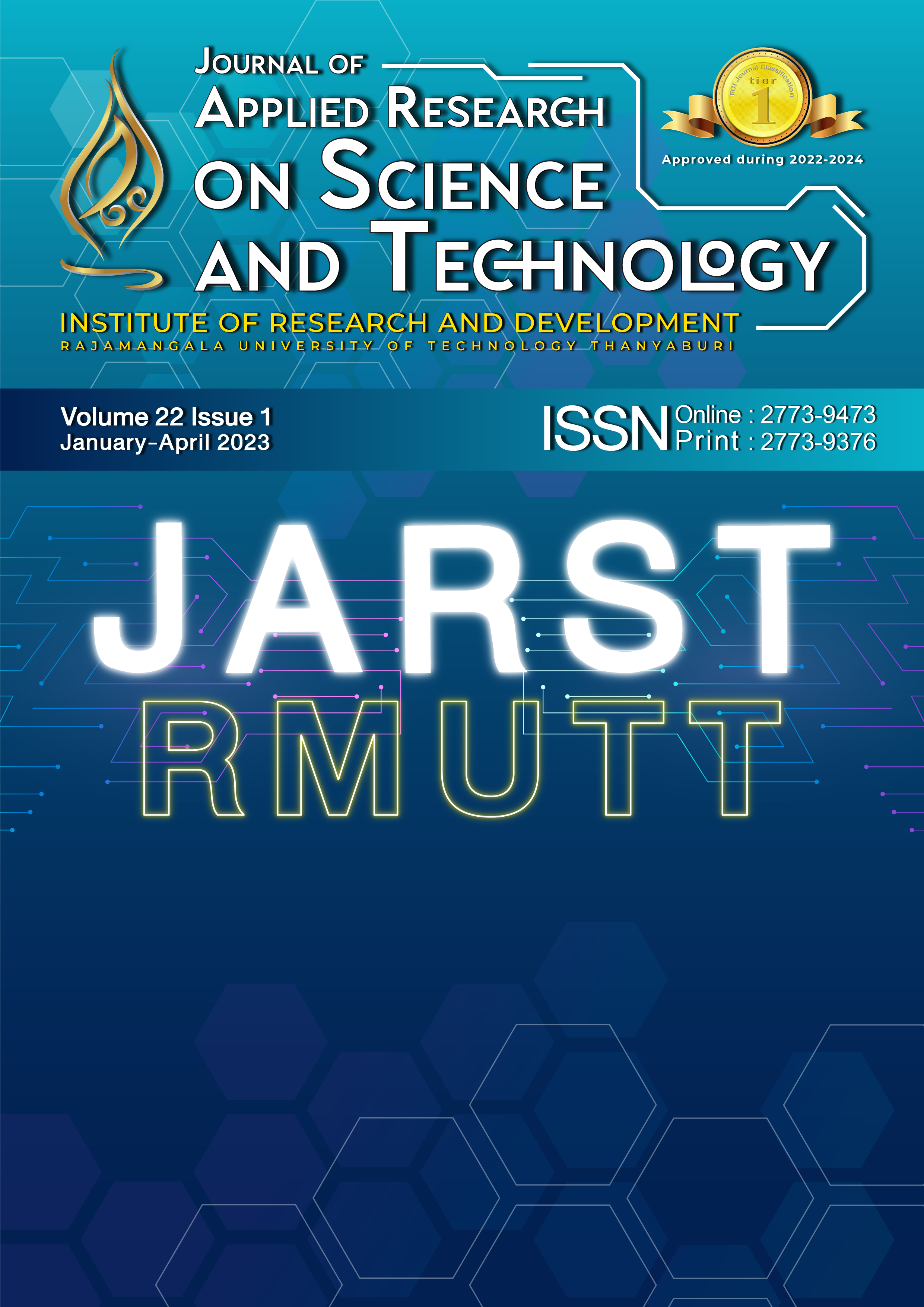Chemical Composition and Toxicity of Peel of Native Species Mango in Sa Kaeo Province Against Spodoptera litura
Main Article Content
Abstract
The purpose of this research was to study the phytochemical screening, antioxidation and efficiency to control Spodoptera litura of mango peel which is a native species in Sa Kaeo province, Thailand. According to phytochemical preliminary study of mango peel, 5 types were found: alkaloids, flavonoids, coumarins, tannins and terpenoids. The extract of mango peel with ethyl acetate solvent showed the highest total phenolic content and total tannins content which were 403.10±0.02 mg GAE/g and 330.78 ±0.02 mg TAE/g, respectively. For total flavonoids content, the highest was found in dichloromethane extract at 255.11±0.02 mg QE/g. The antioxidant activity study obtained from DPPH free radical scavenging showed the highest in methanol extract (EC50 value was 4.38±0.03 μg/ml). In the addition, it was found that the contact toxicity test by topical application of mango peel extract was able to control Spodoptera litura. In which the active substance extracted with ethyl acetate, it showed the best effect at 24 and 48 hours (2,392.14±0.13 and 1,580.26±0.12 mg/l, respectively). Therefore, ethyl acetate extract was analyzed by high performance liquid chromatography (HPLC), in which only gallic acid was found. It can control many bacteria and insects. Overall results suggest that mango peels from Sa Kaeo province can be further studied for using in insect control plans to reduce the use of chemical pesticides.
Article Details

This work is licensed under a Creative Commons Attribution-NonCommercial-NoDerivatives 4.0 International License.
References
Krish S. Antioxidant activity, beta-carotene, lycopene and flavonoid content of Thai native cultivars of green mango (Mangifera indica) after harvest. UTK research journal. 2019;13(1):68-81.
Ban Bo Nang Ching Mango Producer Group Community Enterprise. 2018. Nam dok mai sakaeo mango. Thai patent No. สช 62100122.
Data on mango production. Sa Kaeo province [Internet]. Sa Kaeo: Sa Kaeo provincial agricultural extension office 2021 [update 2022 Aug 31; cite 2020 Oct 20]. Availability from: http://www.sakaeo.doae.go.th/site/?page_id=2044
Nongluk H. Phytochemical screening and biological activities some thai medicinal plants using in the diabetes therapy [dissertation]. Faculty of science: Burapha University; 2016.
Abdalla AEM, Darwish SM, Ayad EHE, El-Hamahmy RM. Egyptian mango by-product 1. Compositional quality of mango seed kernel. Food Chem. 2007;103(4):1134-40.
Ribeiro VLS, Avancini C, Goncalves K, Toigo E, Poser GV. Investigation of the acaricidal activity of Calea serrata (Asteraceae) on Boophilus microplus and Rhipicephalus sanguineus. Vet Parasitol. 2008;151:351–4.
Makare N, Bodhankar S, Rangari V. Immunomodulatory activity of alcoholic extract of Mangifera indica L. in mice. J Ethnopharmacol. 2001;78(2-3):133-7.
Doughari JH, Manzara S. In vitro antibacterial activity of crude leaf extracts of Mangifera indica Linn. Afr J Microbiol Res. 2008;2:67-72.
Emam M, Abdel Haleem DR, El Ansari MA, Sobeh M. Larvicidal activity of pentagalloyl glucose and mangiferin isolated from the waste of mango kernel against Culex pipiens L. Waste and biomass Valorization. 2022;3:83–93.
Da-Camara CAG, Carvalho-Ribeiro NDC, De-Melo JPR, De-Moraes MM. Insecticidal. Potential of citrus and mango essential and selected constituents on silverleaf whitefly. Revista Caatinga. 2020;33(1):90-9.
Ayoola GA, Adesegun SA, Adepoju-Bello AA, Obaweya K, Ezennia EC, Atangbayila TO. Phytochemical screening and antioxidant activities of some selected medicinal plants used for malaria therapy in southwestern nigeria. Trop J Pharm Res. 2008;7(3):1019-24.
Majhenic L, kerge MS, Knez Z. Antioxidant and antimicrobial activity of guarana seed extracts. Food Chemist. 2007;104(3):1258-68.
Arvouet-Grand A, Vennat B, Pourrat A, Legret P. Standardization d’uneextrait de propolis et identification des principaux constituents. J Pharm Belg. 1994;49(6):462-8.
Tsai CJ, Harding SA, Jiang H, Jeong ML, Casado FL, Lin HW. Functional genomics analysis of foliar condensed tannin and phenolic glycoside regulation in natural cottonwood hybrids. Tree Physiol. 2005;25:1475–86.
Braca A, Sortino C, Politi M, Morelli I, Mendez J. Antioxidant activity of flavonoids from Licania licaniaeflora. J Ethnopharmacol. 2002;79(3):379-81.
Yearul K, Hossain US, Jiwan S. Phytochemical compounds in functional properties of mangoes. Wiley Online Library 2007;12:237-54.
Nopdol K, Rawit P, Choosaeng P, Kanjana K. Efficacy of plant extracts for controlling of rice weevil (Sitophilus oryzae). Agriculture and Technology Journal. 2021:2(2):85-94.
Sultana B, Anwar F, Ashraf M. Effect of extraction solvent technique on the antioxidant activity of selected medicinal plant extract. Molecules. 2009;14(6):2167-80.
Piyata A, Wichanee M. Antioxidant Activityand tyrosinase inhibition of mango crude extracts (Mangiferaindica Linn.). The 1st RUSNC, 2016 Jul 22. Rajamangala university of technology Suvarnabhumi. Ayutthaya: Rajamangala university of technology Suvarnabhumi; 2016.
Abbasi AM, Guo X, Fu X, Zhou L, Chen Y, Zhu Y. Comparative assessment of phenolic content and in vitro antioxidant capacity in the pulp and peel of mango cultivars. Inter J Mol Sci. 2015;16:13507-27.
López-Cobo A, Verado V, Diaz-de-Cerio E, Segura-Carretero A, FernandezGutiérrez A, Gomez-Caravaca AM. Use of HPLC- and GC–QTOF to determine hydrophilic and lipophilic phenols in mango fruit (Mangifera indica L.) and its by-products. Food Res Int. 2017;100:423–4.
Pacheco-Ordaz R, Antuñes-Ricardo M, Gutiérrez-Uribe JA, GonzálezAguilar GA. Intestinal permeability and cellular antioxidant activity of phenolic compounds from mango (Mangifera indica cv. Ataulfo) peels. Int J Mol Sci. 2018;1:514. doi.org/10.3390/ijms19020514
Donatus EO, Vitus E. Evalution of the phytochemical composition of mango (Mangifera Indica Linn) stem bark and leaves. Int J Chem Sci. 2008;6(2):705-16.
Esi R, Sri NK, Rodesia MR, Muhammad A, Emrizal E. Phytochemical screening and antioxidant profiling of Sumatran wild mangoes (Mangifera spp.): a potential source for medicine antidegenerative effects. PubMed Central.2019;9:220. doi: 10.12688/f1000research.22380.3.
Ramirez JE, Zambrano R, Sepulveda B, Simirgiotis MJ. Antioxidant properties and hyphenated HPLC–PDA–MS profiling of Chilean Pica mango fruits (Mangifera indica L. cv. piqueno). Mol. 2013;19:438–58.
Matheyambath AC, Subramanian J, Paliyath G. “Mangoes reference module in food science,” in Encyclopedia of food and health. Eds B C Paul and F F Told (Switzerland: Elsevier). 2016;641–5. doi: 10.1016/B978-0-12-384947-2.00442-6
Jiraporn N, Supawadee K. Marigold flower (Tagetes erecta L.) crude extract on killing the mealybug. Academic Journal of Science and Applied Science. 2019:1:45-54.


